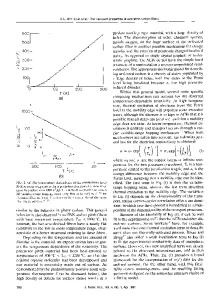Structural characterization of heat-treated activated carbon fibers
- PDF / 695,890 Bytes
- 7 Pages / 576 x 792 pts Page_size
- 37 Downloads / 329 Views
A. W. P. Fung Department of Electrical Engineering and Computer Science, Massachusetts Institute of Technology, Cambridge, Massachusetts 02139
M. S. Dresselhaus Department of Electrical Engineering and Computer Science and Department of Physics, Massachusetts Institute of Technology, Cambridge, Massachusetts 02139
M. Endo Faculty of Engineering, Department of Electrical Engineering, Shinshu University, Nagano 380, Japan (Received 10 January 1992; accepted 13 March 1992)
Raman scattering, x-ray diffraction, and BET measurements are used to study the effect of heat treatment on the microstructure of activated carbon fibers (ACFs) and to correlate the structural changes with the metal-insulator transition observed in the electronic transport properties of heat-treated ACFs. A sequence of events is identified, starting with desorption, followed by micropore collapse plus the stacking of basic structural units in the c-direction, and ending up with in-plane crystallization. The graphitization process closely resembles that depicted by Oberlin's model, except that the final material at high-temperature heat treatment remains turbostratic. Because the metal-insulator transition was observed to occur at heat-treatment temperature Tm ~ 1200 °C, which is well below the J H T value (2000 °C) for in-plane crystallization, we conclude that this electronic transition is not due to in-plane ordering but rather to the collapse of the micropore structure in the ACFs. Raman scattering also provides strong evidence for the presence of local two-dimensional graphene structures, which is the basis for the transport phenomena observed in heat-treated ACFs. I. INTRODUCTION Activated carbon fibers (ACFs) are highly disordered materials with a high potential for industrial applications because of their large surface areas. ACFs also provide a suitable system for testing scientific theories that have been proposed for highly disordered materials.1 Due to their large specific surface area (SSA) of nearly 3000 m 2 /g, the ACFs have a large density of defects that play an important role in their transport and optical properties, and give rise to photoconductivity and localization effects.23 Their huge SSA has made ACFs a good adsorption agent for solvents and gases, and a useful material for making double layer capacitors.4 Preliminary measurements of the temperature dependence of the electrical conductivity and magnetoresistance,1'3 photoconductivity,2 and Raman spectra5 of ACFs have previously been carried out to obtain insight into the transport mechanism and the role of defects in the transport properties of ACFs. For highly disordered and inhomogeneous materials such as ACFs, it is necessary to characterize their physical properties by several experimental techniques so that the complemena
*Present address: Department of Physics and Astronomy, University of Kentucky, Lexington, Kentucky 40506.
1788 http://journals.cambridge.org
J. Mater. Res., Vol. 7, No. 7, Jul 1992 Downloaded: 18 Dec 2014
tary information thus obtained can be cor
Data Loading...











